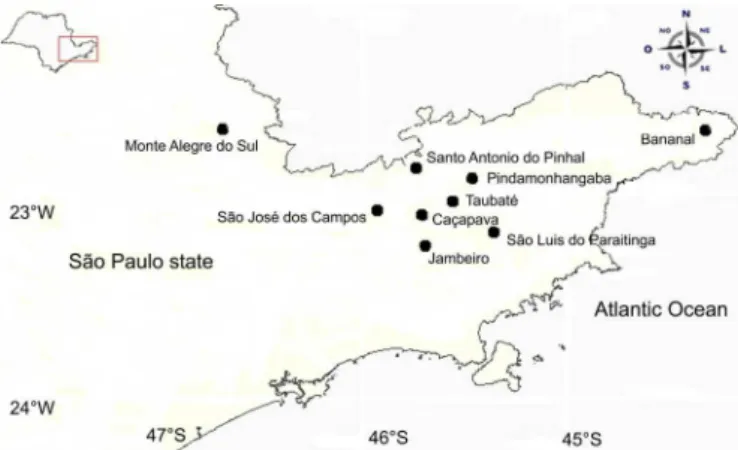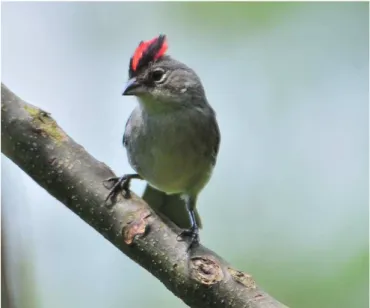Journal of species lists and distribution
Chec
List
ISSN 1809-127X (online edition) © 2010 Check List and Authors
Open Access | Freely available at www.checklist.org.br
501
N
O
T
E
S
O
N
G
E
O
G
R
A
P
H
I
C
D
I
S
T
R
I
B
U
T
I
O
N
The Pileated Finch Coryphospingus pileatus (Wied, 1821) is a small (13 cm) passerine that inhabit arid scrub and edges of woodlands from 0 to 1,600 m of altitude in the north of Venezuela, most of north Colombia and French Guiana and an extensive area from northeast to central, east and part of southeastern regions in Brazil (Stotz et al. 1996; Sick 1997; Ridgely and Tudor 2009). Despite the inexistence of global species estimates, C. pileatus is considered common to fairly common on its broad 2,760,000 km2 geographical range estimate (Stotz et al. 1996; BirdLife International 2010).
In Brazil, the Rio de Janeiro and Minas Gerais states are treated as the austral limit in the occurrence of C. pileatus (Sick 1997; Ridgely and Tudor 2009). Pacheco et al. (1997) retracted the record of this species mentioned by A.P. Leão in the municipality of Piraí (22o37’ S, 48o54’
W), on south of Rio de Janeiro. Despite it, a non-published record at the municipality of Rio Claro, 22o43’ S, 44o86’ W;
(J.F. Pacheco, unpub. data) reveals that the species occurs in southernmost areas of this state at least since 1960s. In southern Minas Gerais, the occurrence of C. pileatus is notorious, and some species records extend from Guaxupé (21o19’ S, 46o40’ W; J.F. Pacheco and D. Pioli, unpub. data),
Alfenas (21o25’ S, 45o56’ W; Pacheco and Bauer 2003),
Varginha region (21o3’ S, 45o30’ W; Lopes 2006), Baependi
(21o57’ S, 44o53’ W; Pinto 1952), Aiuruoca (22o06’ S,
44o41’ W; Vasconcelos 2008), and Maria da Fé (22o17’ S,
45o23’ W; Pinto 1944).
In the present note, we firstly documented the species
to São Paulo state. On 16 December 1990, J.F. Pacheco and P.S. Fonseca recorded a pair of this species in Bananal municipality (22o40’ S, 44o19’ W), nearest to the border
with Rio de Janeiro state. Recently, on 11 September 2009, C. Cestari observed a male moving through a transitional vegetation among secondary native Atlantic forest mixed with non native Eucalyptus spp. in Jambeiro municipality (23o16’ S, 45o45’ W, Figure 1). As far as we
know, this is the southernmost geographic species record.
Abstract: The Pileated Finch Coryphospingus pileatus has an extensive geographic range that encompasses northeast to central, east and part of southeastern regions in Brazil. In southeastern region, Rio de Janeiro and Minas Gerais states were
treated as southern limit of the species distribution. In the present note, we firstly documented the species to São Paulo
state, extending to southern its old-believed geographic distribution. We argued several records of C. pileatus in Vale do Paraíba region since 40 years ago. We also hypothesized the future geographic expansion of the species in São Paulo state.
1 Universidade Estadual Paulista “Júlio de Mesquita Filho”, Instituto de Biociências, Departamento de Zoologia. Avenida 24-A, Bela Vista. CEP 13506-900. Rio Claro, SP, Brazil.
2 Comitê Brasileiro de Registros Ornitológicos. Rua Bambina 50, apto. 104. CEP 22251-050. Rio de Janeiro, RJ, Brazil. * Corresponding author. E-mail: cesar_cestari@yahoo.com.br
César Cestari 1* and José Fernando Pacheco 2
Aves, Emberizidae,
Coryphospingus pileatus
(Wied,
1821): a new gathered bird species to São Paulo state
and evidences of southern geographic expansion in
Brazil
Check List | Volume 6 | Issue 4 | 2010
Jambeiro is located on Vale do Paraíba region, nearly 100 km straight line from the last southernmost point of the species recorded by J.F. Pacheco in Rio Claro municipality, Rio de Janeiro state. Concerning our records, we further discovered more recent non published records of this species concentrated on Vale do Paraíba region through an online database of Brazilian bird photos (WikiAves 2010). These records encompassed four more municipalities: Monte Alegre do Sul, São José dos Campos, São Luís do Paraitinga, Santo Antônio do Pinhal (Figure 2), and Taubaté. Additionally, there are records of C. pileatus on Vale do Paraíba municipalities of Caçapava, Pindamonhangaba and Taubaté, over 40 years-old, gathered from an experienced ornithologist of the region (H.M.F. Alvarenga, personal communication, Figure 1). We believe that the records mentioned above were from wild birds, but we do not discard the possibility that some individuals escaped from captivity or were apprehended by government authorities and released in the region in consequence of illegal pet trade.
All the cited records of C. pileatus in Vale do Paraíba
reflect the lack of published studies on the presence of
Figure 1. Municipalities in which Pileated Finches (Coryphospingus
502
Cestari and Pacheco | Aves, Emberizidae, Coryphospingus pileatus (Wied, 1821)
Check List | Volume 6 | Issue 4 | 2010
the species in the region. Furthermore, these data may indicate a southern geographic range expansion to São Paulo state that possibly started in the 1970s. Probably, historical human activity such agriculture, cattle ranching and deforestation on Vale do Paraíba (Dean 1996) created suitable open and arid habitats to the species. Currently, the species is recorded in abandoned farms, coffee plantations, and arid habitats (H.M.F. Alvarenga, personal communication).
Figure 1. Male of Pileated Finch (Coryphospingus pileatus) photografed by Rafael Fortes on 02 October 2009 in Santo Antônio do Pinhal, São Paulo state, Brazil.
There are other examples of other species such as
Patagioenas picazuro (Temminck, 1813), Fluvicola nengeta
(Linnaeus, 1766), Furnarius figulus (Lichtenstein, 1823) and Netta erythrophthalma (Wied, 1832) which had southern range expansions and were primarily observed in the northeast region of São Paulo state (Alvarenga 1990; Willis 1991; Alvarenga et al. 2006). Nowadays, some of these species (P. picazuro and F. nengeta) are widespread in this state, and anthropogenic impacts derived by agriculture and deforestation were pointed as main causes for bird species expansions (Willis and Oniki 1987; Willis 1991). In the case of C. pileatus, additional records will probably help to reveal the main causes of the species presence or future geographic expansion in São Paulo state.
Literature Cited
Alvarenga, H.M.F. 1990. Novos registros e expansões geográficas de aves
no leste do estado de São Paulo. Ararajuba 1(1): 115-117.
Alvarenga, H.M.F., R. Migotto, L.F. Figueiredo, L.M. Lima and C.O. Gussoni.
2006. A expansão da distribuição geográfica de Furnarius figulus
(Lichtenstein, 1823)(Aves: Furnariidae) no sudeste brasileiro.
Atualidades Ornitológicas 134(1): 6-7.
BirdLife International. 2010. Species factsheet: Coryphospingus pileatus. Electronic database accessible at http://www.birdlife.org. Captured on 14 July 2010.
Dean, W. 1996. A ferro e fogo. A história e a devastação da Mata Atlântica brasileira. São Paulo: Companhia das Letras. 484 p.
Lopes, L.E. 2006. As aves da região de Varginha e Elói Mendes, sul de Minas Gerais, Brasil. Acta Biologica Leopondensia 28(1): 46-54. Pacheco, J.F. and C. Bauer. 2003. Levantamento da avifauna da Fazenda
Lagoa entre 1980 a 1992, Monte Belo, MG. Electronic database accessible at http://www.alfenas.com/pt/envirnmt.php. Captured on 15 July 2010
Pacheco, J.F., R. Parrini, B.M. Whitney, C. Bauer and P.S.M. da Fonseca. 1997. Novos registros de aves para o Estado do Rio de Janeiro: Região Norte. Atualidades Ornitológicas 79(1): 4-5.
Pinto, O.M.O. 1944. Catálogo das aves do Brasil. 2ª parte. São Paulo: Secretaria de Agricultura, Indústria e Comércio. Departamento de Zoologia. 700 p.
Pinto, O.M.O. 1952. Súmula histórica e sistemática da ornitologia de Minas Gerais. Arquivos de Zoologia 8(1): 1-51.
Ridgely, R.S. and G. Tudor. 2009. Field guide to the songbirds of South
America. The Passerines. Austin: University of Texas Press. 750 p.
Sick, H. 1997. Ornitologia brasileira. Rio de Janeiro: Nova Fronteira. 912 p.
Stotz, D.F., J.W. Fitzpatrick, T.A. Parker III and D.K. Moskovits. 1996.
Neotropical Birds: Ecology and conservation. Chicago: University of
Chicago Press. 478 p.
Vasconcelos, M.F. 2008. Aves registradas na Serra do Papagaio, município de Aiuruoca, Minas Gerais. Atualidades Ornitológicas
142(1): 6-7.
Willis, E.O. 1991. Expansão geográfica de Netta erythrophthalma,
Fluvicola nengeta e outras aves de zonas abertas com a
“desertificação” antrópica em São Paulo. Ararajuba 2(1): 101-102. Willis, E.O. and Y. Oniki. 1987. Invasions of deforested regions of São
Paulo State by the Picazuro Pigeon, Columba picazuro Temminck, 1813. Ciência e Cultura 39(11): 1064-1065.
WikiAves. 2010. Fotos feitas em São Paulo da espécie Tico-tico-rei-cinza
(Coryphospingus pileatus). Electronic database accessible at http://
www.wikiaves.com.br. Captured on 15 July 2010.
Acknowledgments: We are grateful to Rafael Fortes that gently allowed the picture illustrated in the present paper to be used; and to Paulo S. M.
Fonseca, Dimas Pioli, and C. Bauer who help us in fieldwork. We are also
in debt with Herculano M. F. Alvarenga and Marcelo F. Vasconcelos that conceded valuable distribution information about C. pileatus in Vale do Paraíba and southern Minas Gerais state, respectively.
Received: July 2010
Revised: September 2010
Accepted: September 2010
Published online: October 2010

